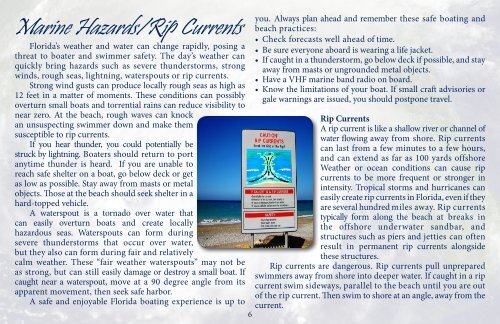2015 Guide
2015 Guide
2015 Guide
Create successful ePaper yourself
Turn your PDF publications into a flip-book with our unique Google optimized e-Paper software.
Marine Hazards/Rip Currents<br />
Florida’s weather and water can change rapidly, posing a<br />
threat to boater and swimmer safety. The day’s weather can<br />
quickly bring hazards such as severe thunderstorms, strong<br />
winds, rough seas, lightning, waterspouts or rip currents.<br />
Strong wind gusts can produce locally rough seas as high as<br />
12 feet in a matter of moments. These conditions can possibly<br />
overturn small boats and torrential rains can reduce visibility to<br />
near zero. At the beach, rough waves can knock<br />
an unsuspecting swimmer down and make them<br />
susceptible to rip currents.<br />
If you hear thunder, you could potentially be<br />
struck by lightning. Boaters should return to port<br />
anytime thunder is heard. If you are unable to<br />
reach safe shelter on a boat, go below deck or get<br />
as low as possible. Stay away from masts or metal<br />
objects. Those at the beach should seek shelter in a<br />
hard-topped vehicle.<br />
A waterspout is a tornado over water that<br />
can easily overturn boats and create locally<br />
hazardous seas. Waterspouts can form during<br />
severe thunderstorms that occur over water,<br />
but they also can form during fair and relatively<br />
calm weather. These “fair weather waterspouts” may not be<br />
as strong, but can still easily damage or destroy a small boat. If<br />
caught near a waterspout, move at a 90 degree angle from its<br />
apparent movement, then seek safe harbor.<br />
A safe and enjoyable Florida boating experience is up to<br />
6<br />
you. Always plan ahead and remember these safe boating and<br />
beach practices:<br />
• Check forecasts well ahead of time.<br />
• Be sure everyone aboard is wearing a life jacket.<br />
• If caught in a thunderstorm, go below deck if possible, and stay<br />
away from masts or ungrounded metal objects.<br />
• Have a VHF marine band radio on board.<br />
• Know the limitations of your boat. If small craft advisories or<br />
gale warnings are issued, you should postpone travel.<br />
Rip Currents<br />
A rip current is like a shallow river or channel of<br />
water flowing away from shore. Rip currents<br />
can last from a few minutes to a few hours,<br />
and can extend as far as 100 yards offshore<br />
Weather or ocean conditions can cause rip<br />
currents to be more frequent or stronger in<br />
intensity. Tropical storms and hurricanes can<br />
easily create rip currents in Florida, even if they<br />
are several hundred miles away. Rip currents<br />
typically form along the beach at breaks in<br />
the offshore underwater sandbar, and<br />
structures such as piers and jetties can often<br />
result in permanent rip currents alongside<br />
these structures.<br />
Rip currents are dangerous. Rip currents pull unprepared<br />
swimmers away from shore into deeper water. If caught in a rip<br />
current swim sideways, parallel to the beach until you are out<br />
of the rip current. Then swim to shore at an angle, away from the<br />
current.


